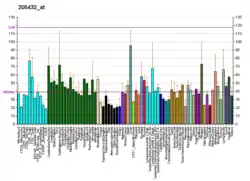OVGP1
Oviduct-specific glycoprotein also known as oviductal glycoprotein (OGP) or estrogen-dependent oviduct protein (EGP) or mucin-9 (MUC9) is a protein that in humans is encoded by the OVGP1 gene.[5][6][7]
Function
Oviduct-specific glycoprotein is a large, carbohydrate-rich, epithelial glycoprotein with numerous O-glycosylation sites located within threonine, serine, and proline-rich tandem repeats. The gene is similar to members of the mucin and the glycosyl hydrolase 18 gene families. Regulation of expression may be estrogen-dependent. Gene expression and protein secretion occur during late follicular development through early cleavage-stage embryonic development. The protein is secreted from non-ciliated oviductal epithelial cells and associates with ovulated oocytes, blastomeres, and spermatozoon acrosomal regions.[7] Beyond the oviduct, OVGP1 is detected in the mouse ovary, testis and epididymis suggesting its roles beyond fertilization. It is not detected in the mouse uterus, cervix, vagina, breast, seminal vesicles and prostate gland [8] OVGP1 is expressed by the surface epithelium of the endometrium at the time of embryo implantation in the mouse. It is required for maintain the receptivity phenotype and trophoblast adhesion, OVGP1 mRNA levels are reduced in endometrium of women with recurrent implantation failure [9]
References
- GRCh38: Ensembl release 89: ENSG00000085465 - Ensembl, May 2017
- GRCm38: Ensembl release 89: ENSMUSG00000074340 - Ensembl, May 2017
- "Human PubMed Reference:". National Center for Biotechnology Information, U.S. National Library of Medicine.
- "Mouse PubMed Reference:". National Center for Biotechnology Information, U.S. National Library of Medicine.
- Arias EB, Verhage HG, Jaffe RC (Feb 1995). "Complementary deoxyribonucleic acid cloning and molecular characterization of an estrogen-dependent human oviductal glycoprotein". Biol Reprod. 51 (4): 685–94. doi:10.1095/biolreprod51.4.685. PMID 7819450.
- Lapensee L, Paquette Y, Bleau G (Nov 1997). "Allelic polymorphism and chromosomal localization of the human oviductin gene (MUC9)". Fertil Steril. 68 (4): 702–8. doi:10.1016/S0015-0282(97)00317-8. PMID 9341614.
- "Entrez Gene: OVGP1 oviductal glycoprotein 1, 120kDa (mucin 9, oviductin)".
- Laheri, Saniya; Modi, Deepak; Bhatt, Purvi (Mar 2017). "Extra-oviductal expression of oviductal glycoprotein 1 in mouse: Detection in testis, epididymis and ovary". Journal of Biosciences. 42 (1): 69–80. doi:10.1007/s12038-016-9657-2. PMID 28229966. S2CID 10274575. Retrieved 16 July 2018.
- Laheri, Saniya; Ashary, Nancy; Bhatt, Purvi; Modi, Deepak (2018). "Oviductal glycoprotein 1 (OVGP1) is expressed by endometrial epithelium that regulates receptivity and trophoblast adhesion". Journal of Assisted Reproduction and Genetics. 35 (8): 1419–1429. doi:10.1007/s10815-018-1231-4. PMC 6086790. PMID 29968069.
- Laheri, Saniya; Ashary, Nancy; Bhatt, Purvi; Modi, Deepak (2018). "Oviductal glycoprotein 1 (OVGP1) is expressed by endometrial epithelium that regulates receptivity and trophoblast adhesion". Journal of Assisted Reproduction and Genetics. 35 (8): 1419–1429. doi:10.1007/s10815-018-1231-4. PMC 6086790. PMID 29968069.
Further reading
- Verhage HG, Fazleabas AT, Donnelly K (1988). "The in vitro synthesis and release of proteins by the human oviduct". Endocrinology. 122 (4): 1639–45. doi:10.1210/endo-122-4-1639. PMID 3278893.
- Iontcheva I, Oppenheim FG, Troxler RF (1997). "Human salivary mucin MG1 selectively forms heterotypic complexes with amylase, proline-rich proteins, statherin, and histatins". J. Dent. Res. 76 (3): 734–43. doi:10.1177/00220345970760030501. PMID 9109822. S2CID 39525421.
- Iontcheva I, Oppenheim FG, Offner GD, Troxler RF (2000). "Molecular mapping of statherin- and histatin-binding domains in human salivary mucin MG1 (MUC5B) by the yeast two-hybrid system". J. Dent. Res. 79 (2): 732–9. doi:10.1177/00220345000790020601. PMID 10728974. S2CID 27558675.
- Agarwal A, Yeung WS, Lee KF (2002). "Cloning and characterization of the human oviduct-specific glycoprotein (HuOGP) gene promoter". Mol. Hum. Reprod. 8 (2): 167–75. doi:10.1093/molehr/8.2.167. PMID 11818519.
- Strausberg RL, Feingold EA, Grouse LH, et al. (2003). "Generation and initial analysis of more than 15,000 full-length human and mouse cDNA sequences". Proc. Natl. Acad. Sci. U.S.A. 99 (26): 16899–903. doi:10.1073/pnas.242603899. PMC 139241. PMID 12477932.
- Lok IH, Briton-Jones CM, Yuen PM, Haines CJ (2003). "Variable expression of oviductin mRNA at different stages of human reproductive cycle". J. Assist. Reprod. Genet. 19 (12): 569–76. doi:10.1023/A:1021263132176. PMC 3455833. PMID 12503889.
- Chen Q, Zhang J, Sweet F (2004). "Homology of primate DNA fragments for estrous-associated oviductal glycoprotein". Hereditas. 139 (1): 75–9. doi:10.1111/j.1601-5223.2003.01640.x. PMID 14641477.
- Gerhard DS, Wagner L, Feingold EA, et al. (2004). "The Status, Quality, and Expansion of the NIH Full-Length cDNA Project: The Mammalian Gene Collection (MGC)". Genome Res. 14 (10B): 2121–7. doi:10.1101/gr.2596504. PMC 528928. PMID 15489334.
- Woo MM, Alkushi A, Verhage HG, et al. (2005). "Gain of OGP, an estrogen-regulated oviduct-specific glycoprotein, is associated with the development of endometrial hyperplasia and endometrial cancer". Clin. Cancer Res. 10 (23): 7958–64. doi:10.1158/1078-0432.CCR-04-1261. PMID 15585630.
- Ling L, Lee YL, Lee KF, et al. (2006). "Expression of human oviductin in an immortalized human oviductal cell line". Fertil. Steril. 84 Suppl 2: 1095–103. doi:10.1016/j.fertnstert.2005.06.006. PMID 16209999.
- Kadam KM, D'Souza SJ, Bandivdekar AH, Natraj U (2006). "Identification and characterization of oviductal glycoprotein-binding protein partner on gametes: epitopic similarity to non-muscle myosin IIA, MYH 9". Mol. Hum. Reprod. 12 (4): 275–82. doi:10.1093/molehr/gal028. PMID 16567366.
- Gregory SG, Barlow KF, McLay KE, et al. (2006). "The DNA sequence and biological annotation of human chromosome 1". Nature. 441 (7091): 315–21. Bibcode:2006Natur.441..315G. doi:10.1038/nature04727. PMID 16710414.




